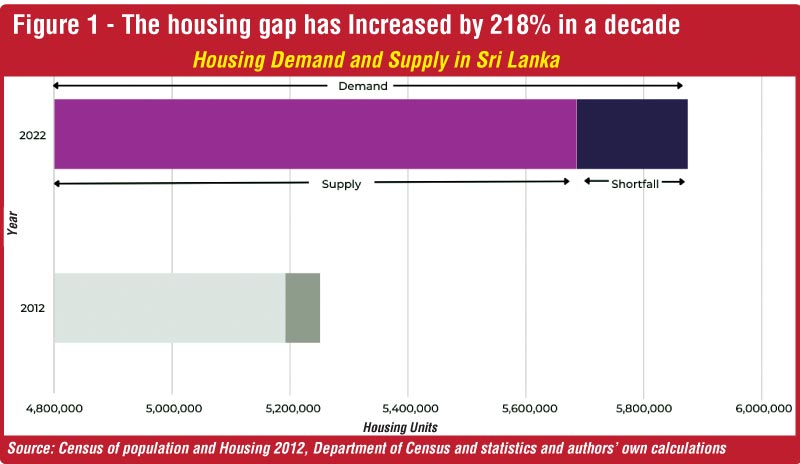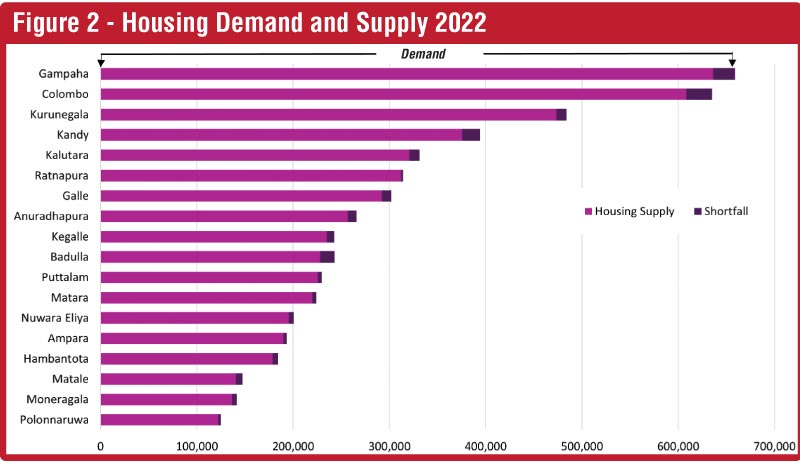Wednesday Apr 16, 2025
Wednesday Apr 16, 2025
Thursday, 15 February 2024 00:05 - - {{hitsCtrl.values.hits}}

|
 Sri Lanka is at a crossroads, confronting with a mounting crisis in housing affordability that demands immediate and comprehensive attention. The complexity of this challenge is underscored by the stark disparities between the escalating housing demand and the sluggish pace of housing supply growth. Data derived from the 2012 Census of Population and Housing Survey paints a stark reality: housing demand has surged by 11.9%, reaching 5,875,009 units from 2012 to 2022. In contrast, housing supply has lagged, with an increase of only 9.5% to 5,685,151 units. This glaring gap which is approximately 3.23% of housing units (189,858) raises a red flag, necessitating urgent and effective policy interventions.
Sri Lanka is at a crossroads, confronting with a mounting crisis in housing affordability that demands immediate and comprehensive attention. The complexity of this challenge is underscored by the stark disparities between the escalating housing demand and the sluggish pace of housing supply growth. Data derived from the 2012 Census of Population and Housing Survey paints a stark reality: housing demand has surged by 11.9%, reaching 5,875,009 units from 2012 to 2022. In contrast, housing supply has lagged, with an increase of only 9.5% to 5,685,151 units. This glaring gap which is approximately 3.23% of housing units (189,858) raises a red flag, necessitating urgent and effective policy interventions.
Delving deeper into the district-wise dynamics exposes the severity of the issue. Colombo, as a critical urban hub, experienced a 10% surge in housing demand, reaching 635,385 units in 2022. However, the corresponding supply increase was a mere 7.4%, resulting in a substantial shortfall of approximately 26,978 units. This scarcity not only exerts upward pressure on house prices but fundamentally challenges the broader affordability of housing, impacting citizens across various socioeconomic strata.
Challenges
At the heart of this crisis lies a multifaceted challenge. Urbanisation, population growth, and evolving societal needs have outpaced the pace at which housing supply is expanding. A legacy of historical housing policies, coupled with limited private sector participation, has left the Government shouldering the bulk of responsibility. The absence of a robust regulatory framework and streamlined approval processes further impedes the swift execution of housing projects. This perfect storm of factors has led to a housing deficit that reverberates across the nation.
To this, in the housing landscape in Sri Lanka, a disconcerting reality emerges from the statistics. Out of the 6,094,115 families, a fraction grapples with precarious living conditions, with 0.73% residing in cadjan/palmyrah houses, 4.56% in temporary structures, and 6.35% inhabiting partly constructed houses. The prevalence of households not yet plastered stands at 13.79%, while 7.25% have roofs consisting of galvanised sheets. Alarmingly, 3.55% represent homeless-landless families, and 0.49% temporarily dwell in quarters for job requirements. Another 2.74% of families are categorised as homeless yet possess a block of land, and 1.31% are temporarily living on rent while maintaining a permanent residence elsewhere. Additionally, 8.39% face challenges with proper water supply, 2.97% lack adequate access to roads, 3.19% lack proper sanitation facilities, and 2.74% are without electricity. These realities underscore the multifaceted challenges faced by a significant portion of the population in securing decent and dignified housing.
Housing demand, a pivotal component, is linked to demographic trends, housing finance accessibility and cost, and Government policies encompassing taxation and subsidies. The precarious nature of property rights, particularly insecure tenure, has the potential to hinder investments in housing. Conversely, housing supply is contingent upon factors such as land availability, robust infrastructure, construction material costs, and market efficiency. The interplay of consumer, producer, and Government behaviour further shapes the delicate equilibrium of demand and supply in the housing sector. Government policies, notably those governing land use and building regulations, wield significant influence over housing construction, subsequently impacting the supply of affordable housing.
Multifaceted approach
To navigate this housing affordability crisis, a multifaceted approach is imperative. Reforming housing policies is imperative for the Government, necessitating an alignment with contemporary needs and fostering adaptability to evolving trends. Priority should be given to strategic reforms that emphasise affordable housing development in both urban and rural areas. Facilitating collaboration between the public and private sectors emerges as a key solution to bridge the housing gap. Incentivising private developers to partake in affordable housing projects, coupled with supportive measures like infrastructure and regulatory facilitation, can yield significant positive outcomes. A pivotal aspect involves strengthening the role and capacity of the National Housing Development Authority (NHDA). This entails regular leadership by the NHDA in conducting comprehensive housing needs assessments that encompass qualitative dimensions. Securing adequate funding, autonomy, and an unwavering commitment to improving living standards within NHDA are indispensable components of this multifaceted strategy.
Housing affordability is not just an economic metric; it's a barometer of societal well-being. A secure, affordable home is the bedrock upon which individuals build their lives. It impacts education, healthcare, and overall community prosperity. Failure to address this crisis risks leaving a lasting scar on the nation's social fabric.
The absence of a cohesive, long-term housing policy focused on low-income housing has significantly contributed to the limited construction of affordable houses. Historically, the Government's housing initiatives, especially in the past two decades, primarily aimed at clearing slums for land development rather than addressing affordable housing concerns directly (The World Bank 2012). Resolving housing policy issues is crucial, and it's equally vital to address market failures in land, building materials, and the construction industry to enhance housing affordability (World Bank 1993).
To enhance the business environment, the Government should transition from being the sole provider of housing to creating a legislative, administrative, and policy framework that fosters a competitive market. Direct Government involvement in construction, coupled with regulatory roles, may lead to conflicts of interest. Instead, policies should incentivise private entities to engage in affordable housing construction. This involves eliminating protectionist measures like import tariffs, para-tariffs, and addressing concentration issues in building materials industries.
Addressing institutional failures is paramount. Multiple agencies with overlapping functions create bottlenecks, hindering policy development and project execution for adequate and affordable housing. Streamlining these agencies, ensuring coordination, and establishing a robust regulatory framework are necessary. Regulatory issues, such as land availability and titling problems, are major barriers. Unlocking Government-owned land for housing projects, improving titling processes, and digitizing land registries can facilitate development and clear ownership, enabling better access to finance.
Provision of infrastructure and support services is crucial. Government investment in public services like water, sanitation, and public transportation can unlock regions for housing development. Improving the efficiency and productivity of the construction industry, potentially through standardised housing units and prefabrication, would significantly reduce construction costs.
Reducing the cost of borrowing and enhancing financing options for low-income households is a challenge. Mortgage guarantees, encouragement for banks to access low-cost wholesale funding, and addressing issues related to land titling and borrower risk can enhance access to affordable financing. Additionally, focusing on the underdeveloped incremental housing finance market can cater to the unique needs of low-income households.
Improving data availability is essential for effective planning. Establishing a centralized mechanism to collect, analyse, and disseminate recent housing data is crucial for long-term planning and achieving sector and economic objectives. Conducting regular surveys and censuses will provide up-to-date insights into the state of the housing sector in Sri Lanka.
In conclusion, addressing these multifaceted challenges requires a holistic and well-coordinated approach involving comprehensive policy reforms, market enhancements, and improvements in data collection and analysis mechanisms.


(The Advocata Institute is an independent think tank working to promote sound public policy ideas for a freer and a more prosperous Sri Lanka. The opinions expressed are the author’s own views. They may not necessarily reflect the views of the Advocata Institute or anyone affiliated with the institute.)
Discover Kapruka, the leading online shopping platform in Sri Lanka, where you can conveniently send Gifts and Flowers to your loved ones for any event including Valentine ’s Day. Explore a wide range of popular Shopping Categories on Kapruka, including Toys, Groceries, Electronics, Birthday Cakes, Fruits, Chocolates, Flower Bouquets, Clothing, Watches, Lingerie, Gift Sets and Jewellery. Also if you’re interested in selling with Kapruka, Partner Central by Kapruka is the best solution to start with. Moreover, through Kapruka Global Shop, you can also enjoy the convenience of purchasing products from renowned platforms like Amazon and eBay and have them delivered to Sri Lanka.
Discover Kapruka, the leading online shopping platform in Sri Lanka, where you can conveniently send Gifts and Flowers to your loved ones for any event including Valentine ’s Day. Explore a wide range of popular Shopping Categories on Kapruka, including Toys, Groceries, Electronics, Birthday Cakes, Fruits, Chocolates, Flower Bouquets, Clothing, Watches, Lingerie, Gift Sets and Jewellery. Also if you’re interested in selling with Kapruka, Partner Central by Kapruka is the best solution to start with. Moreover, through Kapruka Global Shop, you can also enjoy the convenience of purchasing products from renowned platforms like Amazon and eBay and have them delivered to Sri Lanka.